Comprehensive Accounting Systems and Processes Analysis
VerifiedAdded on 2020/02/24
|36
|4795
|29
Homework Assignment
AI Summary
This assignment solution provides a comprehensive analysis of accounting systems and processes, covering various aspects such as cell referencing in Excel, the use of parentheses for negative numbers, designing spreadsheets with separate data entry and report areas, and the application of the IF function. It also delves into inventory valuation systems, specifically the periodic system, with examples. The solution includes a detailed spreadsheet for the trial balance, adjustments, and the benefits of using spreadsheets in accounting. Furthermore, the assignment explores inventory costing methods, including average cost, LIFO, and FIFO, with calculations and examples for a given scenario. The document presents both original and revised versions of the inventory costing problem, demonstrating the application of these methods in detail.
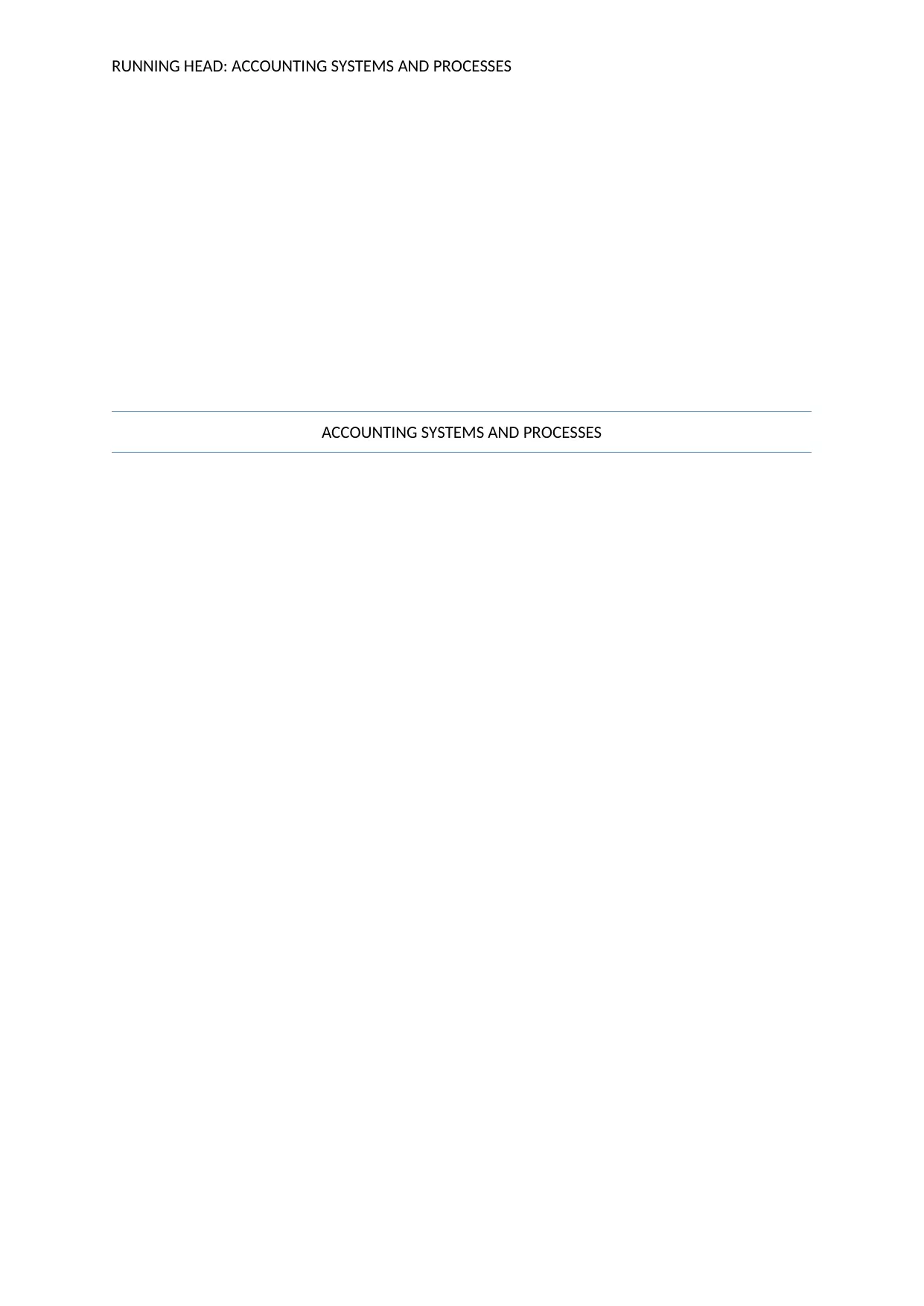
RUNNING HEAD: ACCOUNTING SYSTEMS AND PROCESSES
ACCOUNTING SYSTEMS AND PROCESSES
ACCOUNTING SYSTEMS AND PROCESSES
Paraphrase This Document
Need a fresh take? Get an instant paraphrase of this document with our AI Paraphraser
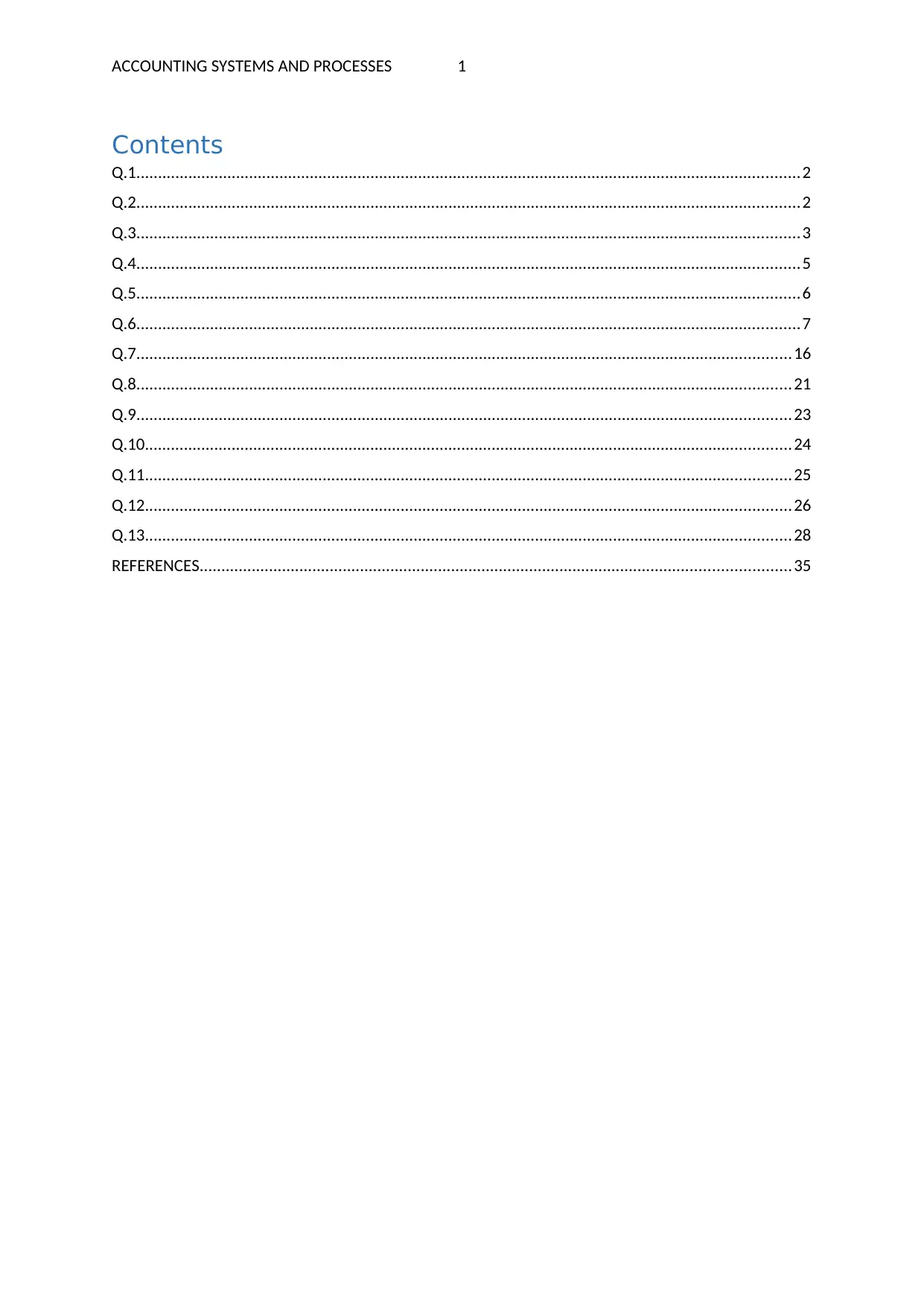
ACCOUNTING SYSTEMS AND PROCESSES 1
Contents
Q.1.........................................................................................................................................................2
Q.2.........................................................................................................................................................2
Q.3.........................................................................................................................................................3
Q.4.........................................................................................................................................................5
Q.5.........................................................................................................................................................6
Q.6.........................................................................................................................................................7
Q.7.......................................................................................................................................................16
Q.8.......................................................................................................................................................21
Q.9.......................................................................................................................................................23
Q.10.....................................................................................................................................................24
Q.11.....................................................................................................................................................25
Q.12.....................................................................................................................................................26
Q.13.....................................................................................................................................................28
REFERENCES........................................................................................................................................35
Contents
Q.1.........................................................................................................................................................2
Q.2.........................................................................................................................................................2
Q.3.........................................................................................................................................................3
Q.4.........................................................................................................................................................5
Q.5.........................................................................................................................................................6
Q.6.........................................................................................................................................................7
Q.7.......................................................................................................................................................16
Q.8.......................................................................................................................................................21
Q.9.......................................................................................................................................................23
Q.10.....................................................................................................................................................24
Q.11.....................................................................................................................................................25
Q.12.....................................................................................................................................................26
Q.13.....................................................................................................................................................28
REFERENCES........................................................................................................................................35
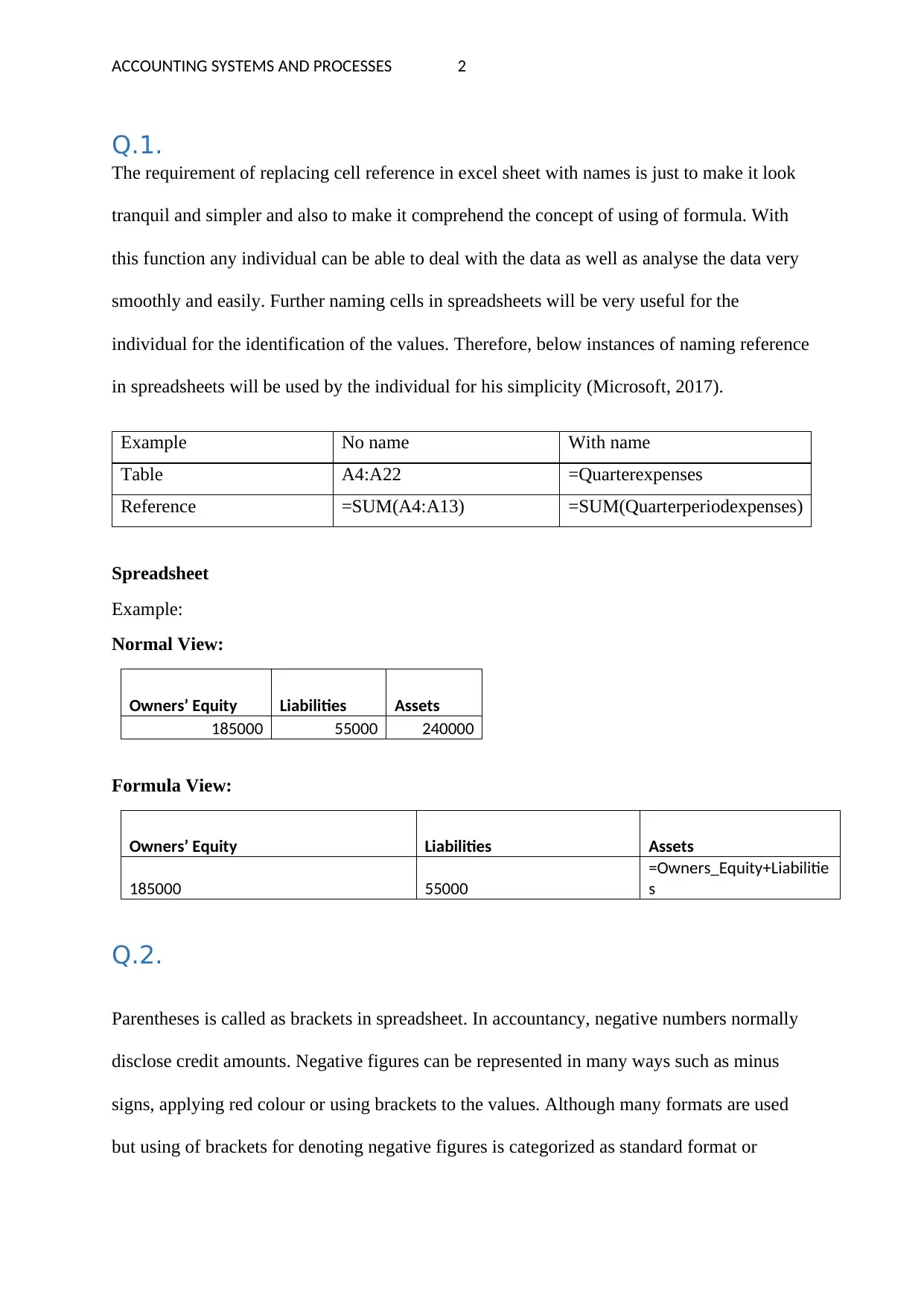
ACCOUNTING SYSTEMS AND PROCESSES 2
Q.1.
The requirement of replacing cell reference in excel sheet with names is just to make it look
tranquil and simpler and also to make it comprehend the concept of using of formula. With
this function any individual can be able to deal with the data as well as analyse the data very
smoothly and easily. Further naming cells in spreadsheets will be very useful for the
individual for the identification of the values. Therefore, below instances of naming reference
in spreadsheets will be used by the individual for his simplicity (Microsoft, 2017).
Example No name With name
Table A4:A22 =Quarterexpenses
Reference =SUM(A4:A13) =SUM(Quarterperiodexpenses)
Spreadsheet
Example:
Normal View:
Owners’ Equity Liabilities Assets
185000 55000 240000
Formula View:
Owners’ Equity Liabilities Assets
185000 55000
=Owners_Equity+Liabilitie
s
Q.2.
Parentheses is called as brackets in spreadsheet. In accountancy, negative numbers normally
disclose credit amounts. Negative figures can be represented in many ways such as minus
signs, applying red colour or using brackets to the values. Although many formats are used
but using of brackets for denoting negative figures is categorized as standard format or
Q.1.
The requirement of replacing cell reference in excel sheet with names is just to make it look
tranquil and simpler and also to make it comprehend the concept of using of formula. With
this function any individual can be able to deal with the data as well as analyse the data very
smoothly and easily. Further naming cells in spreadsheets will be very useful for the
individual for the identification of the values. Therefore, below instances of naming reference
in spreadsheets will be used by the individual for his simplicity (Microsoft, 2017).
Example No name With name
Table A4:A22 =Quarterexpenses
Reference =SUM(A4:A13) =SUM(Quarterperiodexpenses)
Spreadsheet
Example:
Normal View:
Owners’ Equity Liabilities Assets
185000 55000 240000
Formula View:
Owners’ Equity Liabilities Assets
185000 55000
=Owners_Equity+Liabilitie
s
Q.2.
Parentheses is called as brackets in spreadsheet. In accountancy, negative numbers normally
disclose credit amounts. Negative figures can be represented in many ways such as minus
signs, applying red colour or using brackets to the values. Although many formats are used
but using of brackets for denoting negative figures is categorized as standard format or
⊘ This is a preview!⊘
Do you want full access?
Subscribe today to unlock all pages.

Trusted by 1+ million students worldwide
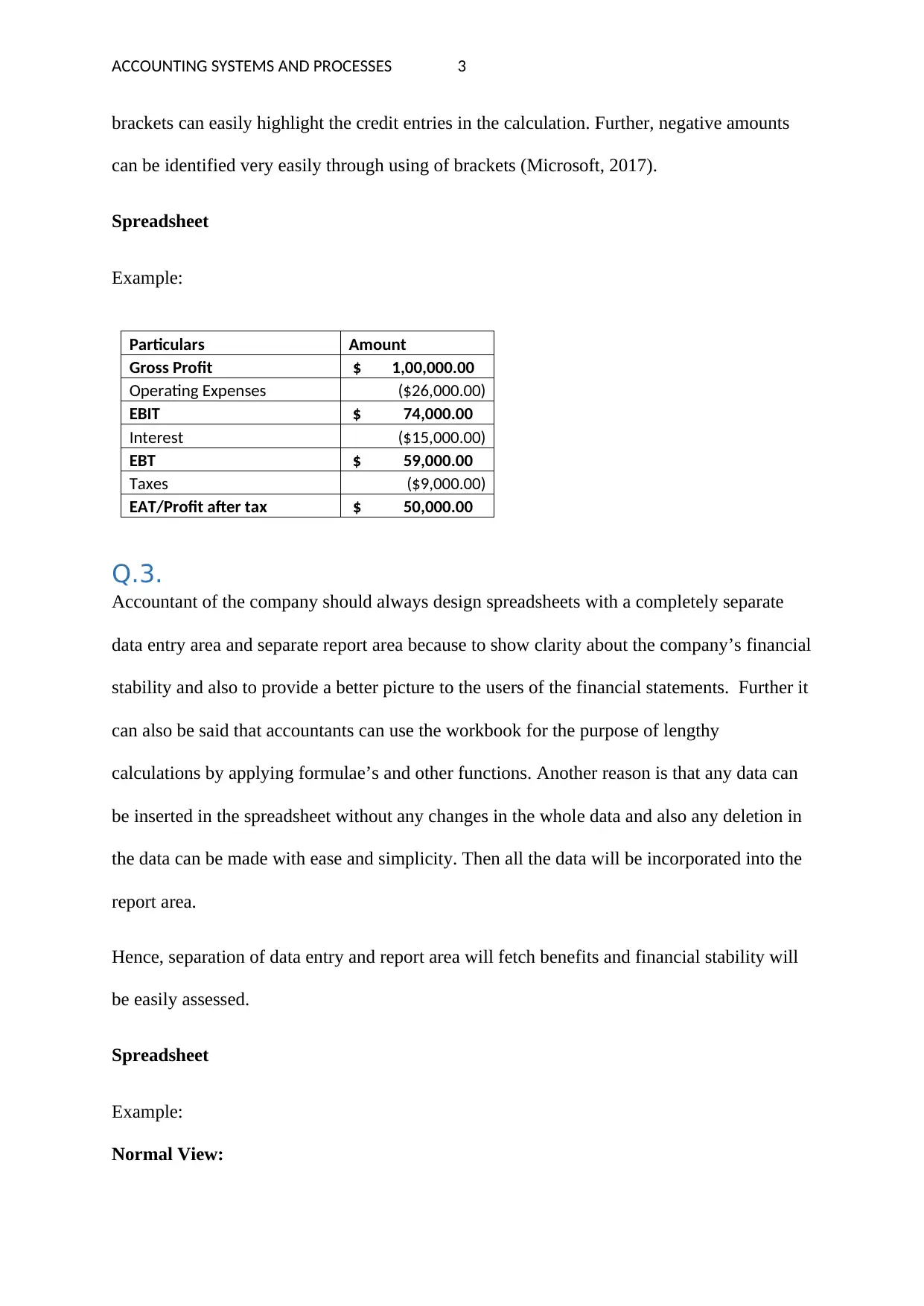
ACCOUNTING SYSTEMS AND PROCESSES 3
brackets can easily highlight the credit entries in the calculation. Further, negative amounts
can be identified very easily through using of brackets (Microsoft, 2017).
Spreadsheet
Example:
Particulars Amount
Gross Profit $ 1,00,000.00
Operating Expenses ($26,000.00)
EBIT $ 74,000.00
Interest ($15,000.00)
EBT $ 59,000.00
Taxes ($9,000.00)
EAT/Profit after tax $ 50,000.00
Q.3.
Accountant of the company should always design spreadsheets with a completely separate
data entry area and separate report area because to show clarity about the company’s financial
stability and also to provide a better picture to the users of the financial statements. Further it
can also be said that accountants can use the workbook for the purpose of lengthy
calculations by applying formulae’s and other functions. Another reason is that any data can
be inserted in the spreadsheet without any changes in the whole data and also any deletion in
the data can be made with ease and simplicity. Then all the data will be incorporated into the
report area.
Hence, separation of data entry and report area will fetch benefits and financial stability will
be easily assessed.
Spreadsheet
Example:
Normal View:
brackets can easily highlight the credit entries in the calculation. Further, negative amounts
can be identified very easily through using of brackets (Microsoft, 2017).
Spreadsheet
Example:
Particulars Amount
Gross Profit $ 1,00,000.00
Operating Expenses ($26,000.00)
EBIT $ 74,000.00
Interest ($15,000.00)
EBT $ 59,000.00
Taxes ($9,000.00)
EAT/Profit after tax $ 50,000.00
Q.3.
Accountant of the company should always design spreadsheets with a completely separate
data entry area and separate report area because to show clarity about the company’s financial
stability and also to provide a better picture to the users of the financial statements. Further it
can also be said that accountants can use the workbook for the purpose of lengthy
calculations by applying formulae’s and other functions. Another reason is that any data can
be inserted in the spreadsheet without any changes in the whole data and also any deletion in
the data can be made with ease and simplicity. Then all the data will be incorporated into the
report area.
Hence, separation of data entry and report area will fetch benefits and financial stability will
be easily assessed.
Spreadsheet
Example:
Normal View:
Paraphrase This Document
Need a fresh take? Get an instant paraphrase of this document with our AI Paraphraser
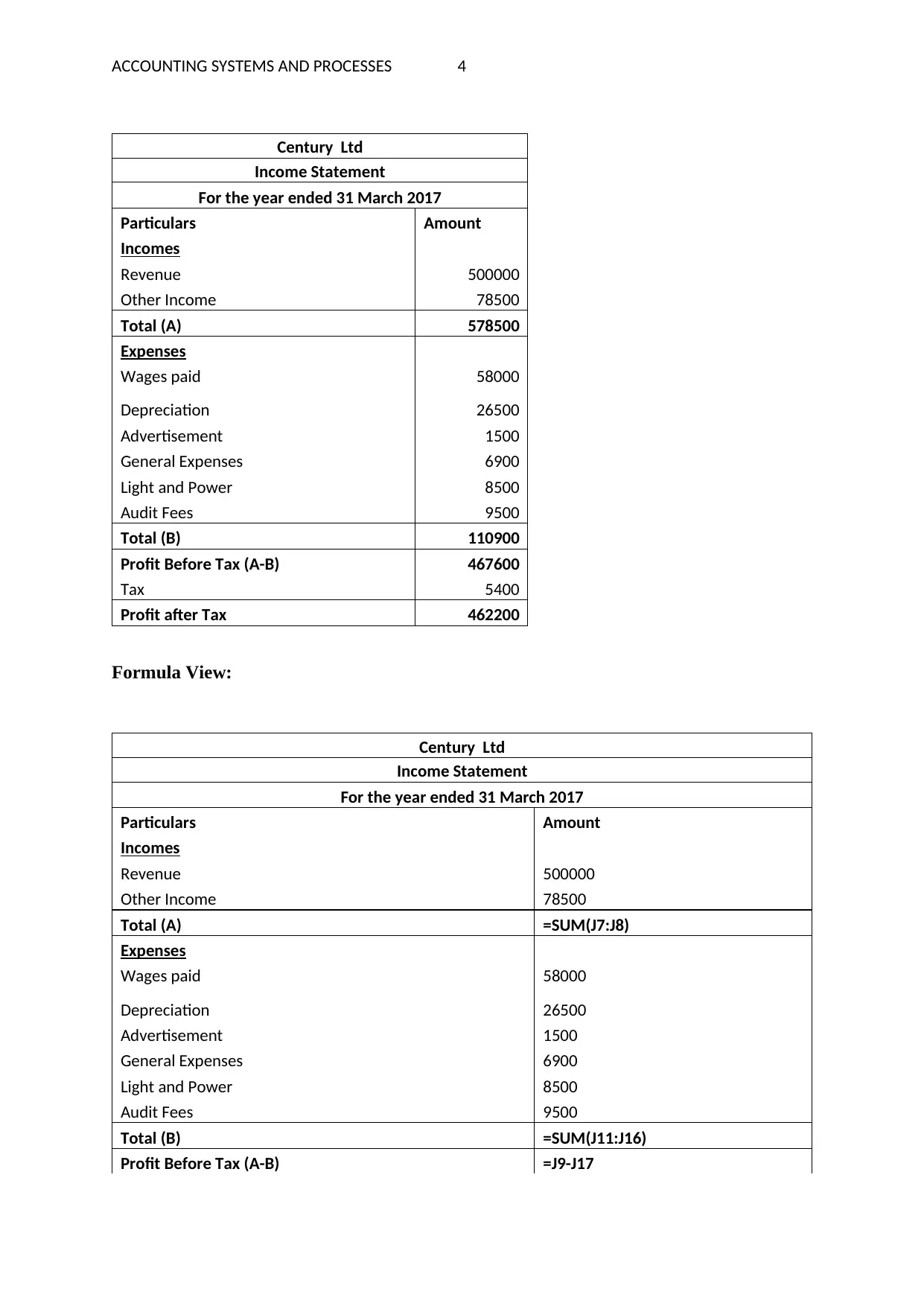
ACCOUNTING SYSTEMS AND PROCESSES 4
Century Ltd
Income Statement
For the year ended 31 March 2017
Particulars Amount
Incomes
Revenue 500000
Other Income 78500
Total (A) 578500
Expenses
Wages paid 58000
Depreciation 26500
Advertisement 1500
General Expenses 6900
Light and Power 8500
Audit Fees 9500
Total (B) 110900
Profit Before Tax (A-B) 467600
Tax 5400
Profit after Tax 462200
Formula View:
Century Ltd
Income Statement
For the year ended 31 March 2017
Particulars Amount
Incomes
Revenue 500000
Other Income 78500
Total (A) =SUM(J7:J8)
Expenses
Wages paid 58000
Depreciation 26500
Advertisement 1500
General Expenses 6900
Light and Power 8500
Audit Fees 9500
Total (B) =SUM(J11:J16)
Profit Before Tax (A-B) =J9-J17
Century Ltd
Income Statement
For the year ended 31 March 2017
Particulars Amount
Incomes
Revenue 500000
Other Income 78500
Total (A) 578500
Expenses
Wages paid 58000
Depreciation 26500
Advertisement 1500
General Expenses 6900
Light and Power 8500
Audit Fees 9500
Total (B) 110900
Profit Before Tax (A-B) 467600
Tax 5400
Profit after Tax 462200
Formula View:
Century Ltd
Income Statement
For the year ended 31 March 2017
Particulars Amount
Incomes
Revenue 500000
Other Income 78500
Total (A) =SUM(J7:J8)
Expenses
Wages paid 58000
Depreciation 26500
Advertisement 1500
General Expenses 6900
Light and Power 8500
Audit Fees 9500
Total (B) =SUM(J11:J16)
Profit Before Tax (A-B) =J9-J17
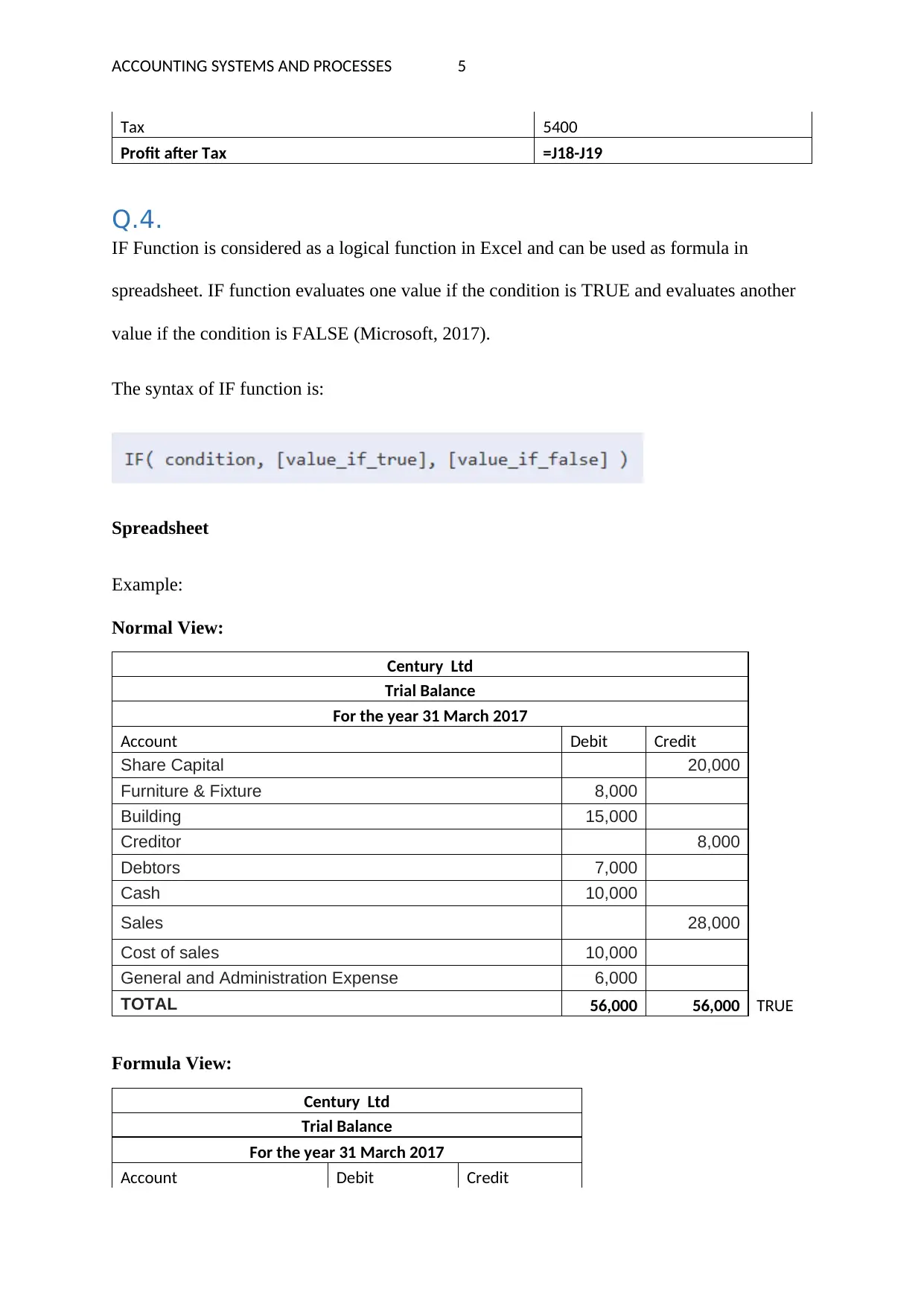
ACCOUNTING SYSTEMS AND PROCESSES 5
Tax 5400
Profit after Tax =J18-J19
Q.4.
IF Function is considered as a logical function in Excel and can be used as formula in
spreadsheet. IF function evaluates one value if the condition is TRUE and evaluates another
value if the condition is FALSE (Microsoft, 2017).
The syntax of IF function is:
Spreadsheet
Example:
Normal View:
Century Ltd
Trial Balance
For the year 31 March 2017
Account Debit Credit
Share Capital 20,000
Furniture & Fixture 8,000
Building 15,000
Creditor 8,000
Debtors 7,000
Cash 10,000
Sales 28,000
Cost of sales 10,000
General and Administration Expense 6,000
TOTAL 56,000 56,000 TRUE
Formula View:
Century Ltd
Trial Balance
For the year 31 March 2017
Account Debit Credit
Tax 5400
Profit after Tax =J18-J19
Q.4.
IF Function is considered as a logical function in Excel and can be used as formula in
spreadsheet. IF function evaluates one value if the condition is TRUE and evaluates another
value if the condition is FALSE (Microsoft, 2017).
The syntax of IF function is:
Spreadsheet
Example:
Normal View:
Century Ltd
Trial Balance
For the year 31 March 2017
Account Debit Credit
Share Capital 20,000
Furniture & Fixture 8,000
Building 15,000
Creditor 8,000
Debtors 7,000
Cash 10,000
Sales 28,000
Cost of sales 10,000
General and Administration Expense 6,000
TOTAL 56,000 56,000 TRUE
Formula View:
Century Ltd
Trial Balance
For the year 31 March 2017
Account Debit Credit
⊘ This is a preview!⊘
Do you want full access?
Subscribe today to unlock all pages.

Trusted by 1+ million students worldwide
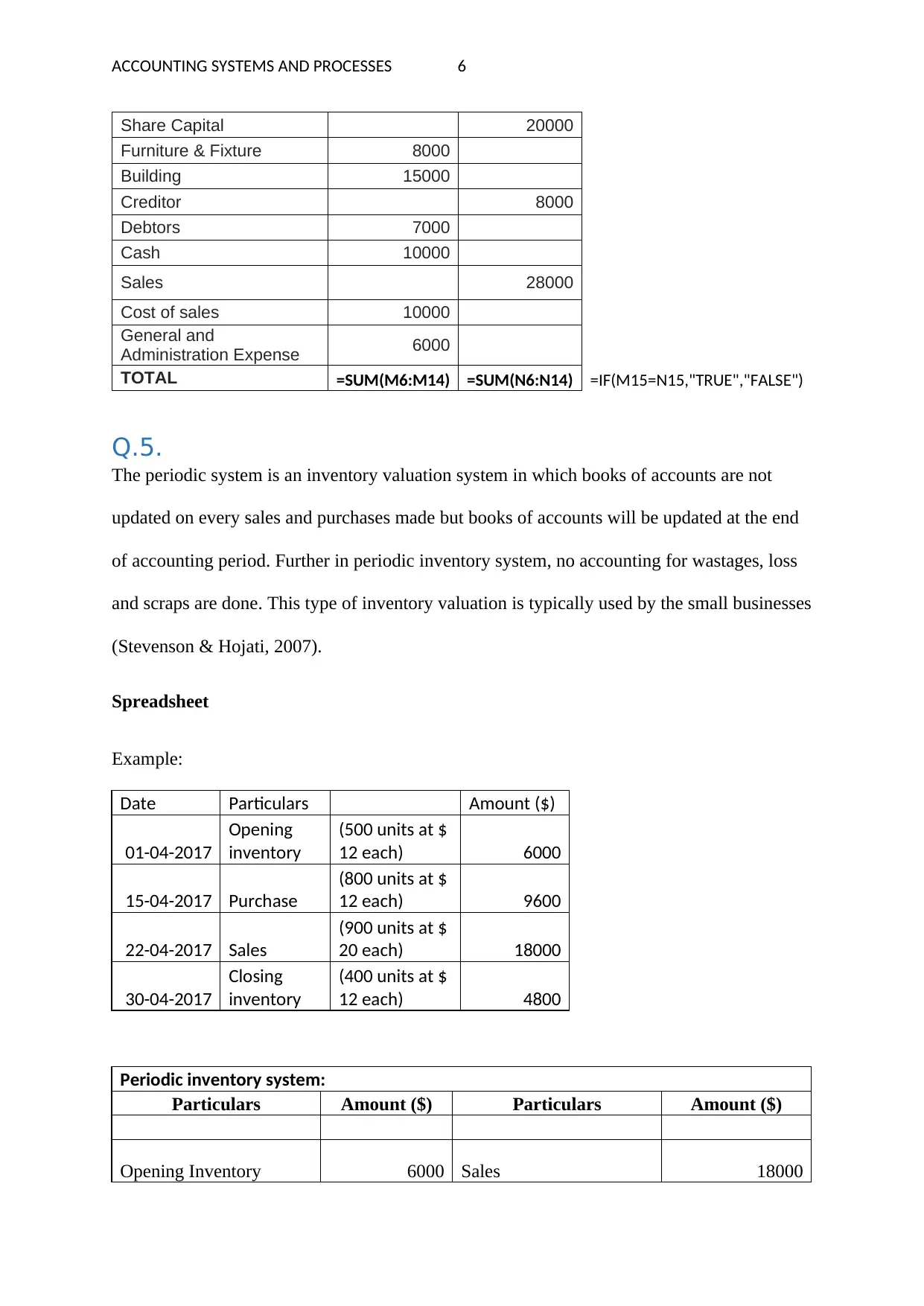
ACCOUNTING SYSTEMS AND PROCESSES 6
Share Capital 20000
Furniture & Fixture 8000
Building 15000
Creditor 8000
Debtors 7000
Cash 10000
Sales 28000
Cost of sales 10000
General and
Administration Expense 6000
TOTAL =SUM(M6:M14) =SUM(N6:N14) =IF(M15=N15,"TRUE","FALSE")
Q.5.
The periodic system is an inventory valuation system in which books of accounts are not
updated on every sales and purchases made but books of accounts will be updated at the end
of accounting period. Further in periodic inventory system, no accounting for wastages, loss
and scraps are done. This type of inventory valuation is typically used by the small businesses
(Stevenson & Hojati, 2007).
Spreadsheet
Example:
Date Particulars Amount ($)
01-04-2017
Opening
inventory
(500 units at $
12 each) 6000
15-04-2017 Purchase
(800 units at $
12 each) 9600
22-04-2017 Sales
(900 units at $
20 each) 18000
30-04-2017
Closing
inventory
(400 units at $
12 each) 4800
Periodic inventory system:
Particulars Amount ($) Particulars Amount ($)
Opening Inventory 6000 Sales 18000
Share Capital 20000
Furniture & Fixture 8000
Building 15000
Creditor 8000
Debtors 7000
Cash 10000
Sales 28000
Cost of sales 10000
General and
Administration Expense 6000
TOTAL =SUM(M6:M14) =SUM(N6:N14) =IF(M15=N15,"TRUE","FALSE")
Q.5.
The periodic system is an inventory valuation system in which books of accounts are not
updated on every sales and purchases made but books of accounts will be updated at the end
of accounting period. Further in periodic inventory system, no accounting for wastages, loss
and scraps are done. This type of inventory valuation is typically used by the small businesses
(Stevenson & Hojati, 2007).
Spreadsheet
Example:
Date Particulars Amount ($)
01-04-2017
Opening
inventory
(500 units at $
12 each) 6000
15-04-2017 Purchase
(800 units at $
12 each) 9600
22-04-2017 Sales
(900 units at $
20 each) 18000
30-04-2017
Closing
inventory
(400 units at $
12 each) 4800
Periodic inventory system:
Particulars Amount ($) Particulars Amount ($)
Opening Inventory 6000 Sales 18000
Paraphrase This Document
Need a fresh take? Get an instant paraphrase of this document with our AI Paraphraser
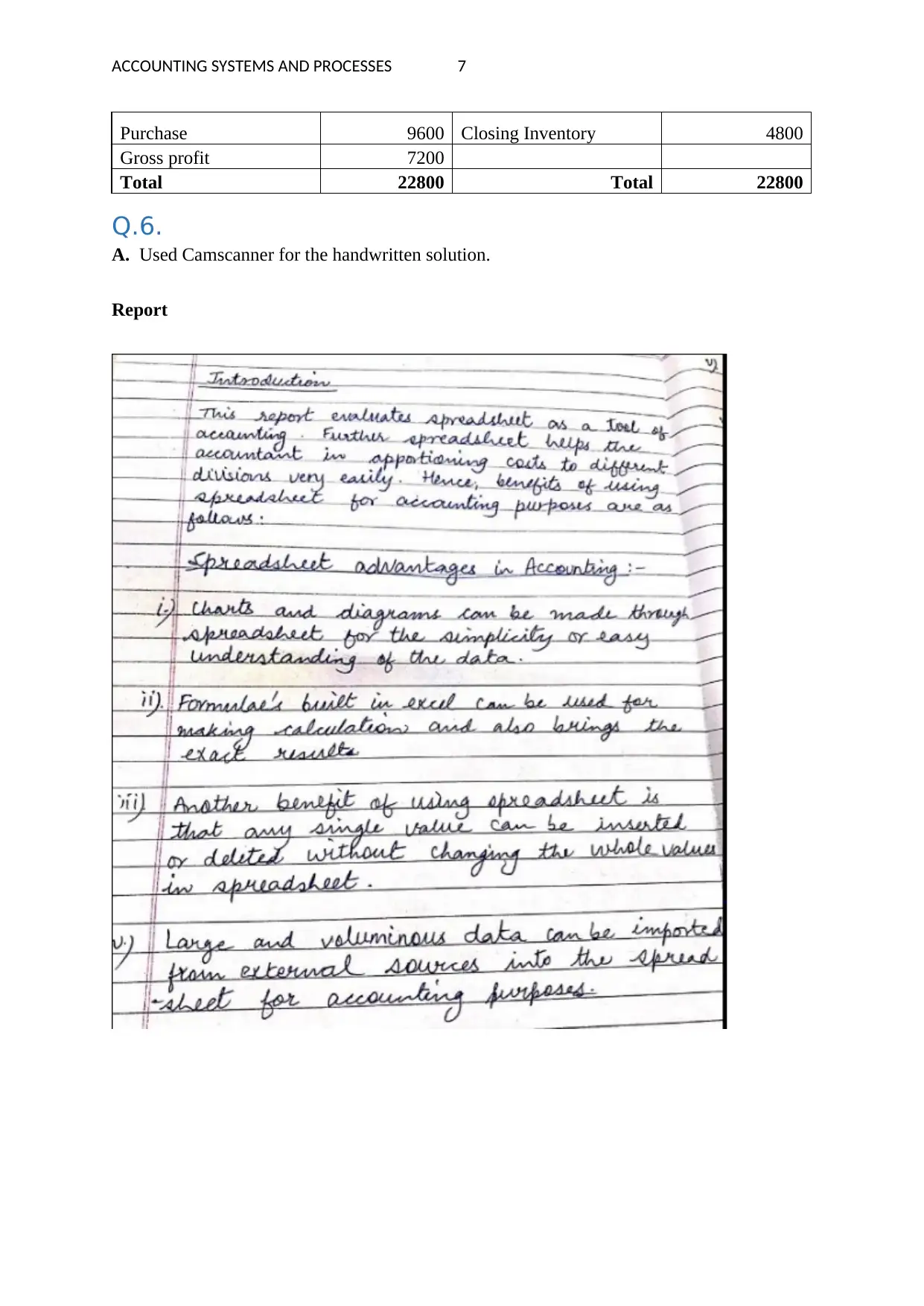
ACCOUNTING SYSTEMS AND PROCESSES 7
Purchase 9600 Closing Inventory 4800
Gross profit 7200
Total 22800 Total 22800
Q.6.
A. Used Camscanner for the handwritten solution.
Report
Purchase 9600 Closing Inventory 4800
Gross profit 7200
Total 22800 Total 22800
Q.6.
A. Used Camscanner for the handwritten solution.
Report
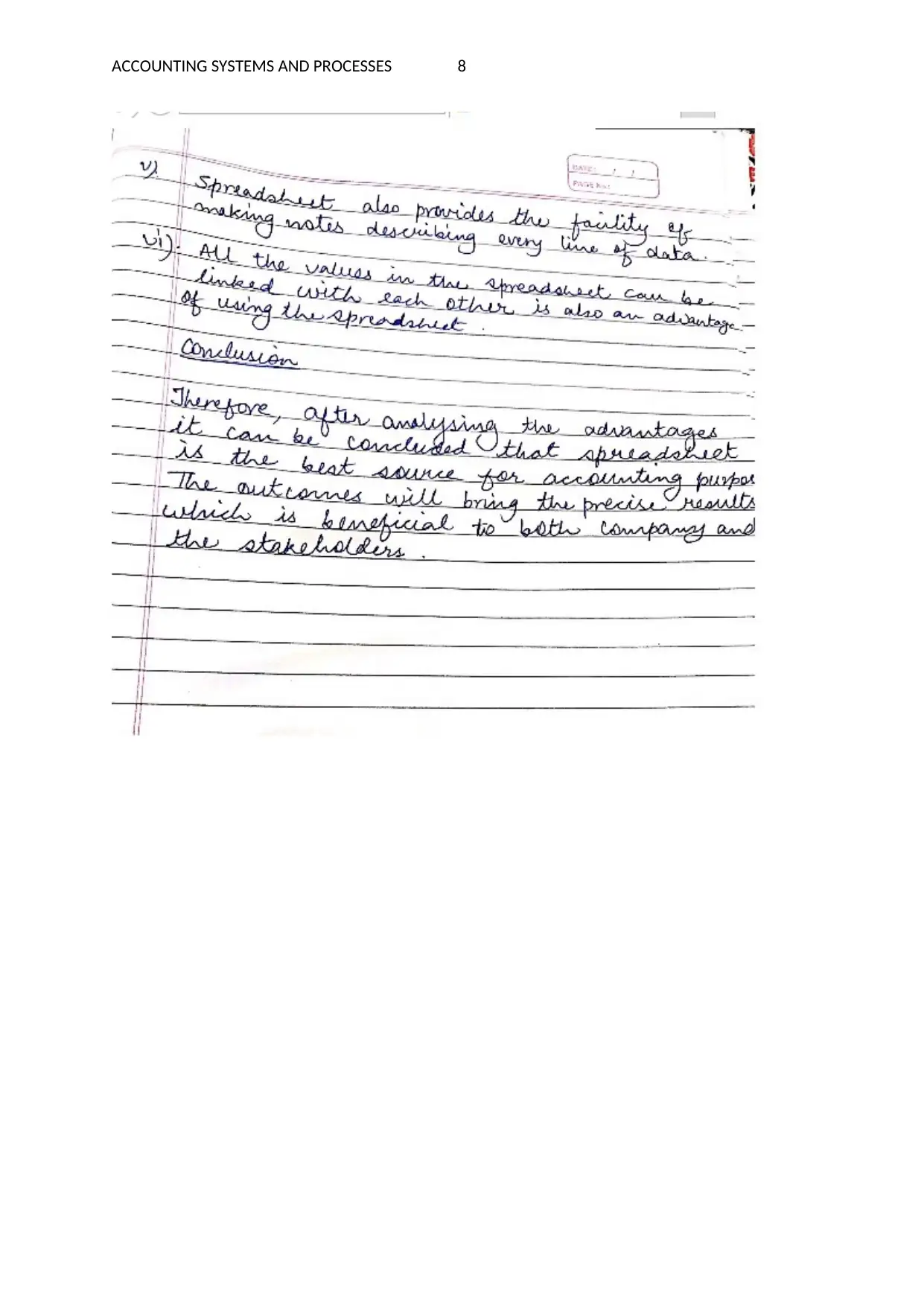
ACCOUNTING SYSTEMS AND PROCESSES 8
⊘ This is a preview!⊘
Do you want full access?
Subscribe today to unlock all pages.

Trusted by 1+ million students worldwide
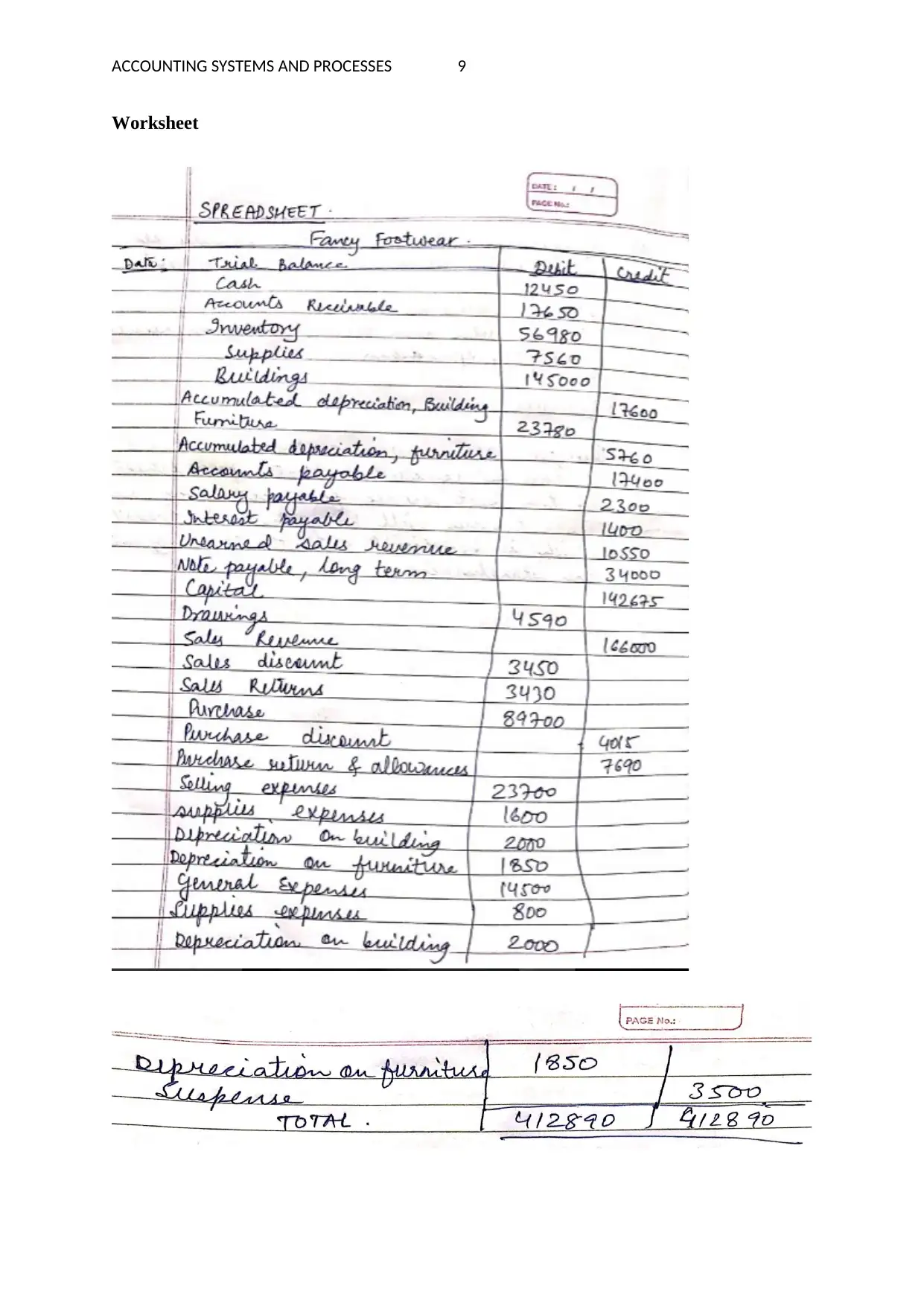
ACCOUNTING SYSTEMS AND PROCESSES 9
Worksheet
Worksheet
Paraphrase This Document
Need a fresh take? Get an instant paraphrase of this document with our AI Paraphraser
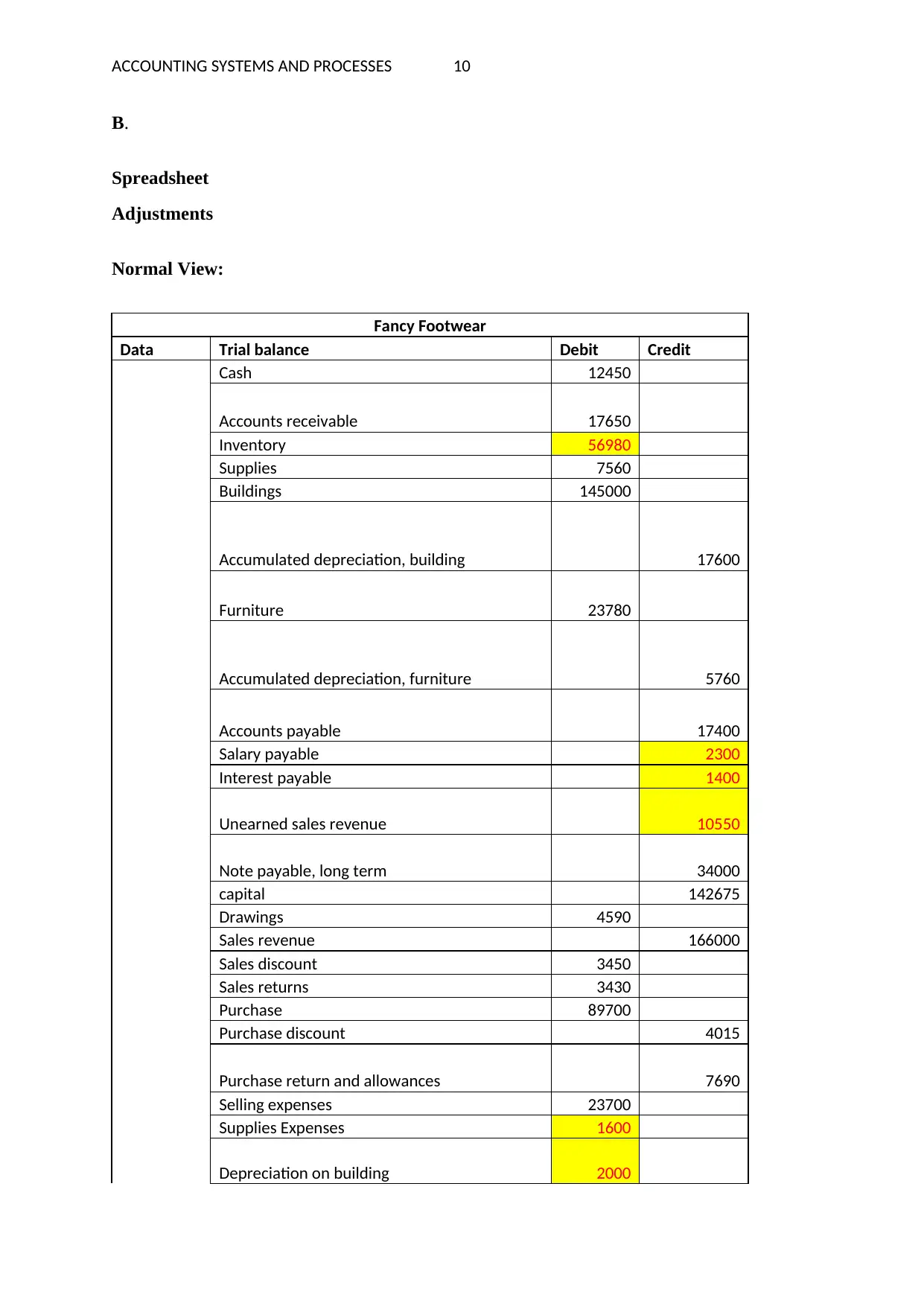
ACCOUNTING SYSTEMS AND PROCESSES 10
B.
Spreadsheet
Adjustments
Normal View:
Fancy Footwear
Data Trial balance Debit Credit
Cash 12450
Accounts receivable 17650
Inventory 56980
Supplies 7560
Buildings 145000
Accumulated depreciation, building 17600
Furniture 23780
Accumulated depreciation, furniture 5760
Accounts payable 17400
Salary payable 2300
Interest payable 1400
Unearned sales revenue 10550
Note payable, long term 34000
capital 142675
Drawings 4590
Sales revenue 166000
Sales discount 3450
Sales returns 3430
Purchase 89700
Purchase discount 4015
Purchase return and allowances 7690
Selling expenses 23700
Supplies Expenses 1600
Depreciation on building 2000
B.
Spreadsheet
Adjustments
Normal View:
Fancy Footwear
Data Trial balance Debit Credit
Cash 12450
Accounts receivable 17650
Inventory 56980
Supplies 7560
Buildings 145000
Accumulated depreciation, building 17600
Furniture 23780
Accumulated depreciation, furniture 5760
Accounts payable 17400
Salary payable 2300
Interest payable 1400
Unearned sales revenue 10550
Note payable, long term 34000
capital 142675
Drawings 4590
Sales revenue 166000
Sales discount 3450
Sales returns 3430
Purchase 89700
Purchase discount 4015
Purchase return and allowances 7690
Selling expenses 23700
Supplies Expenses 1600
Depreciation on building 2000
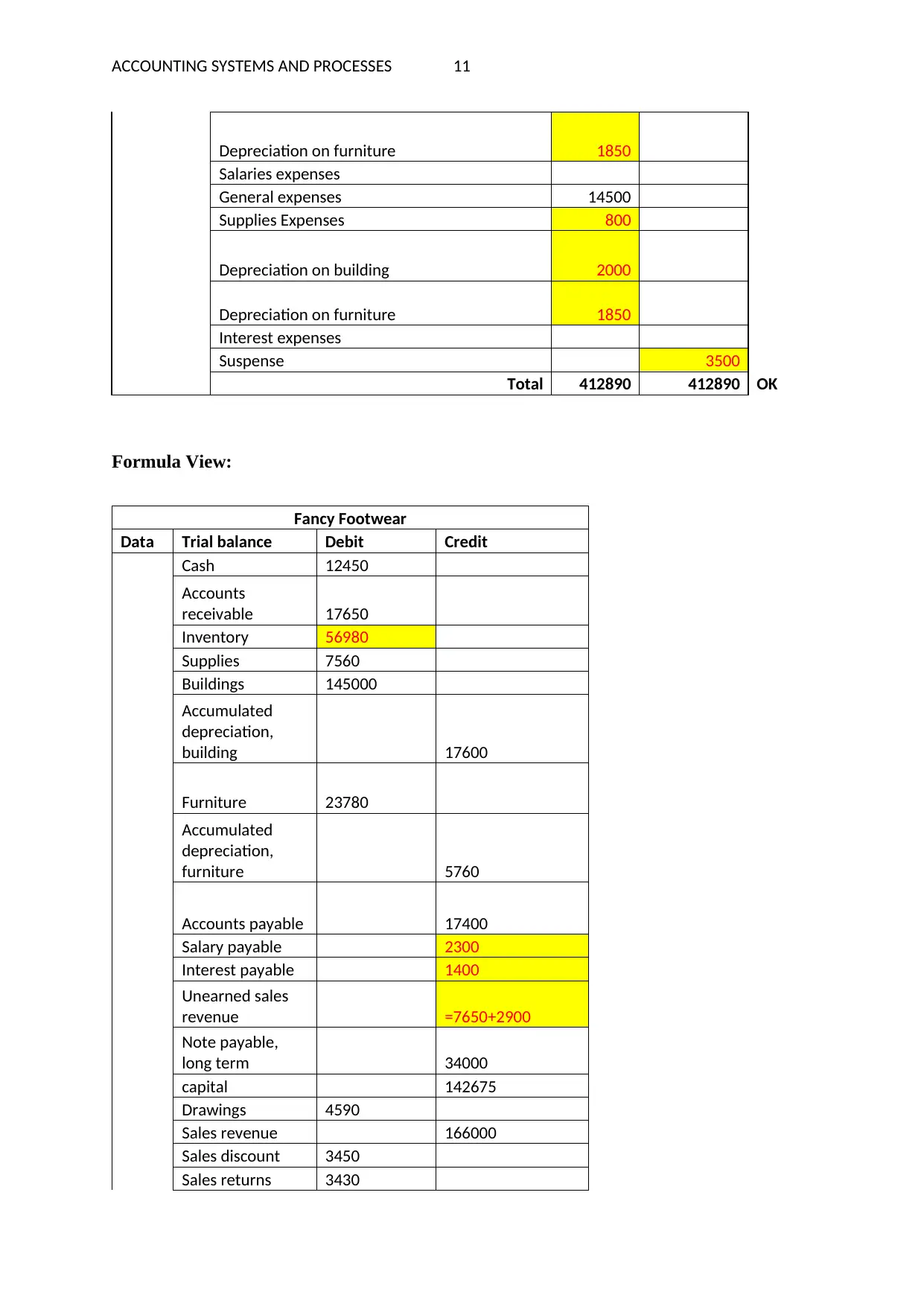
ACCOUNTING SYSTEMS AND PROCESSES 11
Depreciation on furniture 1850
Salaries expenses
General expenses 14500
Supplies Expenses 800
Depreciation on building 2000
Depreciation on furniture 1850
Interest expenses
Suspense 3500
Total 412890 412890 OK
Formula View:
Fancy Footwear
Data Trial balance Debit Credit
Cash 12450
Accounts
receivable 17650
Inventory 56980
Supplies 7560
Buildings 145000
Accumulated
depreciation,
building 17600
Furniture 23780
Accumulated
depreciation,
furniture 5760
Accounts payable 17400
Salary payable 2300
Interest payable 1400
Unearned sales
revenue =7650+2900
Note payable,
long term 34000
capital 142675
Drawings 4590
Sales revenue 166000
Sales discount 3450
Sales returns 3430
Depreciation on furniture 1850
Salaries expenses
General expenses 14500
Supplies Expenses 800
Depreciation on building 2000
Depreciation on furniture 1850
Interest expenses
Suspense 3500
Total 412890 412890 OK
Formula View:
Fancy Footwear
Data Trial balance Debit Credit
Cash 12450
Accounts
receivable 17650
Inventory 56980
Supplies 7560
Buildings 145000
Accumulated
depreciation,
building 17600
Furniture 23780
Accumulated
depreciation,
furniture 5760
Accounts payable 17400
Salary payable 2300
Interest payable 1400
Unearned sales
revenue =7650+2900
Note payable,
long term 34000
capital 142675
Drawings 4590
Sales revenue 166000
Sales discount 3450
Sales returns 3430
⊘ This is a preview!⊘
Do you want full access?
Subscribe today to unlock all pages.

Trusted by 1+ million students worldwide
1 out of 36
Your All-in-One AI-Powered Toolkit for Academic Success.
+13062052269
info@desklib.com
Available 24*7 on WhatsApp / Email
![[object Object]](/_next/static/media/star-bottom.7253800d.svg)
Unlock your academic potential
Copyright © 2020–2025 A2Z Services. All Rights Reserved. Developed and managed by ZUCOL.


